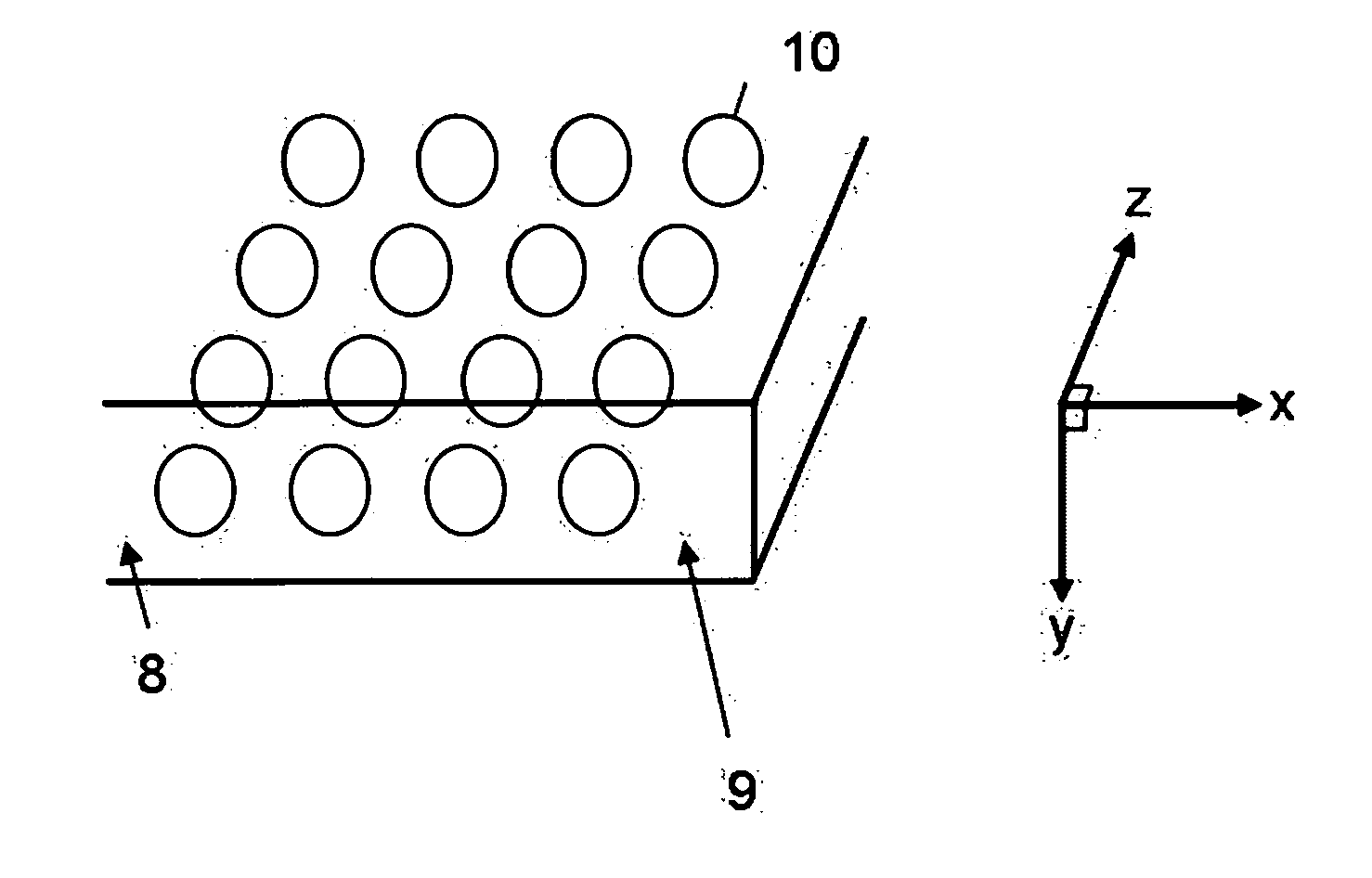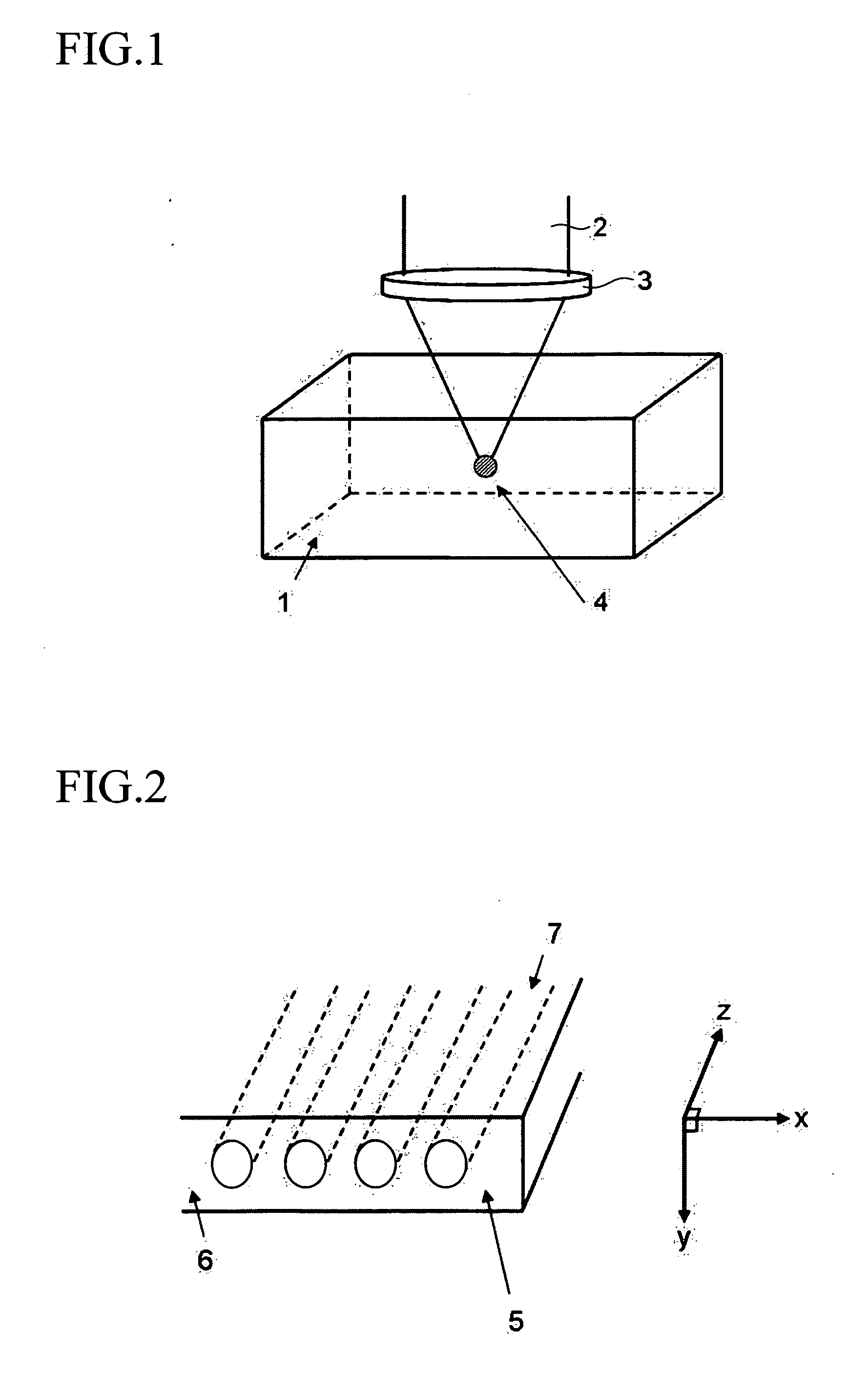Optical component and method of manufacture of optical component
a technology of optical components and optical components, applied in the field of optical components, can solve the problems of unsuitable mass production of components, affecting the compactness of optical systems, and high cost of quartz raw materials, and achieves the effect of high degree of freedom of design and easy manufacturing
- Summary
- Abstract
- Description
- Claims
- Application Information
AI Technical Summary
Benefits of technology
Problems solved by technology
Method used
Image
Examples
first embodiment
[0129] As an optical filter, FIG. 2 shows an optical low-pass filter 5. Here, in this structure regions7 of refractive index N(x, y) different from the refractive index n0 of the substrate are formed in the interior 6 of the transparent substrate with refractive index n0, formed using the method of FIG. 1, in stripe shapes having width a and interval p with periodicity only in the x direction in which the component is to act as the optical low-pass filter. The component this acts as an optical low-pass filter with respect to an object having a high spatial frequency component in one direction.
[0130] In this embodiment, if the cross-sectional shape of the region 7 in the x-y plane of the optical low-pass filter 5 is y=l(x), then the difference ΔL(x) in the optical distances traveled by the light A traversing only the substrate with refractive index n0, and the light B traversing the coordinate x, is expressed by the following equation (1). Δ L(x)=∫lin(x)lout(x)N(x,y) ⅆy-n0...
embodiment 1
[0136] In the above embodiment, regions 7 with refractive index N(x, y) are formed within a substrate with refractive index n0 in stripe shapes, having periodicity in the x direction in the interior of the transparent substrate 6; but an optical low-pass filter of this invention is not limited to the above embodiment, and the periodic structure of a heterogeneous phase in the embodiment 1 may be formed at a different depth in the same substrate, so as to have a periodicity in a different direction.
second embodiment
[0137] Moreover, an optical low-pass filter 9 can be realized in which the region 10 with refractive index N(x, y, z) is formed and arranged in two dimensions to act in two or more directions, having periodicity in the interior of the substrate 8 with refractive index no, such that the refractive index N(x, y, z) or the shape l(x, y, z) also changes in the z direction in FIG. 2. FIG. 12 shows such an optical low-pass filter of a
[0138] The optical low-pass filter 9 of the second embodiment is such that the regions 10 with refractive index N(x, y, z) has periodicity in the x direction and in the z direction, and so has an optical distance difference ΔL(x, z) characteristic as indicated by equation (3) below, and acts as an optical low-pass filter in two or more directions of the object image. Δ L(x)=∫lin(x)lout(x)N(x,y,z) ⅆy-n0l(x,z)(3)
[0139] In this embodiment, as a low-pass filter for a CCD having a pixel arrangement in which pixels are arranged with width 3 μm at interv...
PUM
| Property | Measurement | Unit |
|---|---|---|
| wavelengths | aaaaa | aaaaa |
| refractive index | aaaaa | aaaaa |
| wavelength | aaaaa | aaaaa |
Abstract
Description
Claims
Application Information
 Login to View More
Login to View More - R&D
- Intellectual Property
- Life Sciences
- Materials
- Tech Scout
- Unparalleled Data Quality
- Higher Quality Content
- 60% Fewer Hallucinations
Browse by: Latest US Patents, China's latest patents, Technical Efficacy Thesaurus, Application Domain, Technology Topic, Popular Technical Reports.
© 2025 PatSnap. All rights reserved.Legal|Privacy policy|Modern Slavery Act Transparency Statement|Sitemap|About US| Contact US: help@patsnap.com



